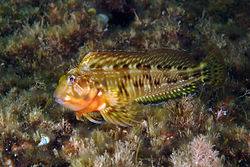Combtooth blennies
| Combtooth blennies | |
|---|---|
 |
|
| Scartella cristata | |
| Scientific classification | |
| Kingdom: | Animalia |
| Phylum: | Chordata |
| Class: | Actinopterygii |
| Order: | Perciformes |
| Superfamily: | Blennioidei |
| Family: |
Blenniidae Rafinesque, 1810 |
| Genera | |
|
See text |
|
See text
Combtooth blennies are blennioids; perciform marine fish of the family Blenniidae. They are the largest family of blennies with around 400 known species. Combtooth blennies are found in tropical and subtropical waters in the Atlantic, Pacific and Indian Oceans; some species are also found in brackish and even freshwater environments.
The body plan of the combtooth blennies is archetypal to all other blennioids; their blunt heads and eyes are large, with large continuous dorsal fins (which may have three to 17 spines). Their bodies are compressed, elongated, and scaleless; their small, slender pelvic fins (which are absent in only two species) are situated before their enlarged pectoral fins, and their tail fins are rounded. As their name would suggest, combtooth blennies are noted for the comb-like teeth lining their jaws.
By far the largest species is the eel-like hairtail blenny at 53 cm in length; most other members of the family are much smaller. Combtooth blennies are active and often highly colourful, making them popular in the aquarium hobby.
Generally benthic fish, combtooth blennies spend much of their time on or near the bottom. They may inhabit the rocky crevices of reefs, burrows in sandy or muddy substrates, or even empty shells. Generally found in shallow waters, some combtooth blennies are capable of leaving the water for short periods during low tide, aided by their large pectoral fins which act as "feet". Small benthic crustaceans, mollusks, and other sessile invertebrates are the primary food items for most species; others eat algae or plankton.
...
Wikipedia
